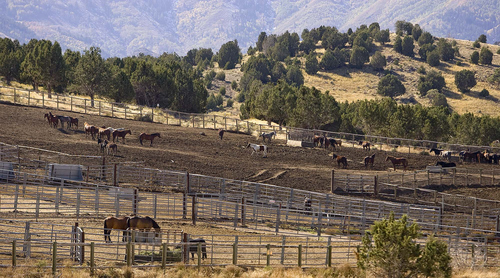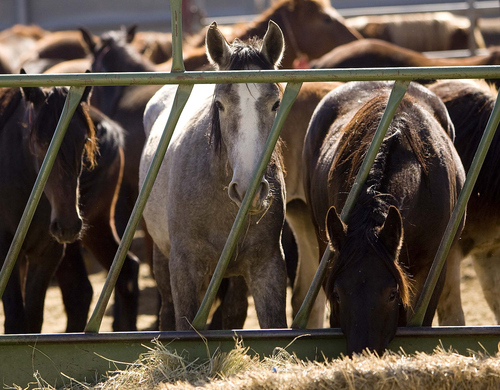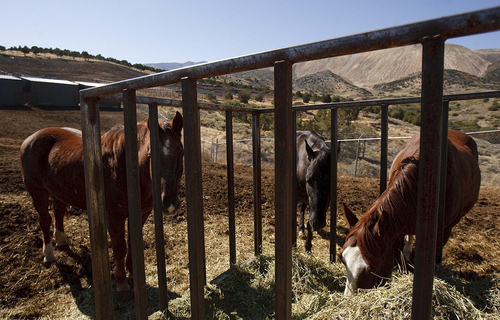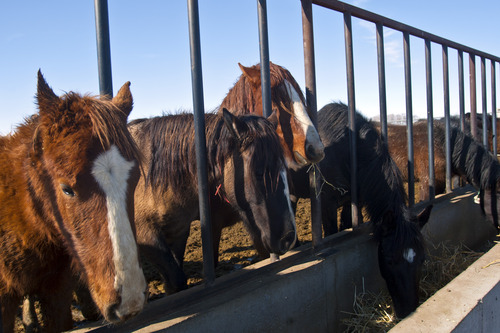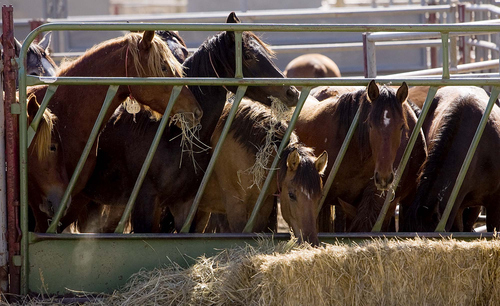This is an archived article that was published on sltrib.com in 2013, and information in the article may be outdated. It is provided only for personal research purposes and may not be reprinted.
A panel of independent experts is calling on the Bureau of Land Management to bring better science and more birth control to its beleaguered wild horse and burro program, which has removed thousands of animals from Utah and other Western states' rangelands in recent years.
The National Academy of Science's National Research Council on Wednesday released a 451-page report that finds "business as usual" will be hard on both free-ranging equids and taxpayers, who foot the staggering bill of corralling and caring for 50,000 animals in long-term holding facilities. Rounding up horses could be doing more harm than good, but BLM's scientific methods lack the rigor to determine whether roundups are necessary or effective, the 14-member panel concluded.
"If populations density were to increase to the point that there was not enough forage available, it could result in fewer pregnancies and lower young-to-female ratios and survival rates," the report states. "Decreased competition for forage through removals may instead allow population growth, which then drives the need to remove more animals."
In a news release, BLM officials say they welcomed the report's findings and recommendations, but did not address its criticisms.
"Our agency is committed to protecting and managing these iconic animals for current and future generations," Deputy Director Neil Kornze said. "The BLM shares the committee's view that although no quick or easy fixes exist to this pressing issue, investments in science-based management approaches, exploring additional opportunities for population control, and increased transparency could lead to a more cost-effective program that manages wild horses and burros with greater public confidence."
These animals may not be legally hunted and they face no pressure from predators, which have been eradicated from the range long ago. The best way to control their numbers is through contraception and chemical vasectomies, concludes the new report titled "Using Science to Improve the BLM Wild Horse and Burro Program: A Way Forward."
Currently, wild horses populations grow by 15 percent to 20 percent a year, effectively doubling every four years.
"No one wants to see more horses in long-term holding," said committee chair Guy Palmer of Washington State University. "If horse populations just continue to grow, regardless of how much rangeland is allocated to them, two things are assured to happen. The rangeland is actually destroyed for use by other wild animals, and eventually the horses themselves will become ill and unthrifty due to inadequate feed and access to water."
How many horses are out there may be anyone's guess. BLM says 37,300, but its counting procedure does not yield reliable numbers. The agency could be underestimating populations on its 102 horse management areas by 10 percent to 50 percent, the report said.
BLM also does an inadequate job of assessing the availability of forage — estimates used to determine how many horses a unit can support — and the effectiveness of its management practices.
But the scientific panel sympathized with the agency, which has to balance the conflicting perspectives of ranchers and animal-welfare advocates, while trying to meet its obligations to both maintain genetically healthy free-ranging horse herds and protect federally owned rangelands.
Horse advocates called the report a "scathing rebuke" of BLM policies, which they say are inhumane and unfairly restrict where horses and burros may roam.
"This is a turning point for the decades-long fight to protect America's mustangs," said Neda DeMayo, president of Return to Freedom, one of more than 50 advocacy groups in the American Wild Horse Preservation Campaign.
"The report delivers a strong case for an immediate halt to the roundup and removal of wild horses from the range, an increase in wild horse and population levels and implementation of in-the-wild management using available fertility control options," said Suzanne Roy, the coalition's director.
About half the BLM's horse program's $80 million budget goes to long-term storage of animals, while just 4 percent goes to on-the-range management.


